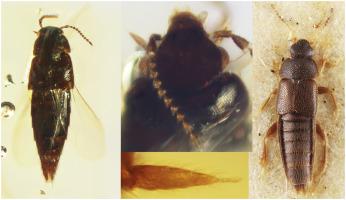Cretaceous Research ( IF 1.9 ) Pub Date : 2021-07-10 , DOI: 10.1016/j.cretres.2021.104951 Shûhei Yamamoto 1, 2 , Alfred F. Newton 2

|
Trichophyinae is one of the smallest subfamilies of the megadiverse rove-beetle family Staphylinidae, with only 18 species in the single extant genus Trichophya Mannerheim. Here we describe the first fossil representative of Trichophyinae in mid-Cretaceous amber from Kachin, northern Myanmar. †Trichophya minor sp. nov. is unusual in having non-filiform thick antennae, similar to T. antennalis Cameron, 1932 from India, but this new species can readily be distinguished from the latter by having much smaller and smoother body. Our finding indicates that the subfamily had been originated by the Albian–Cenomanian boundary, also showing a potential Gondwanan distribution at that time. We also briefly discuss a miniaturization trend in the Burmese amber beetles.
中文翻译:

来自缅甸北部中白垩世琥珀的首个化石毛癣菌甲虫(鞘翅目:葡萄科:毛癣菌科)
Trichophyinae 是大型多样性 rove-beetle 家族 Staphylinidae 中最小的亚科之一,在现存的单个Trichophya Mannerheim属中只有 18 种。在这里,我们描述了缅甸北部克钦邦中白垩纪琥珀中毛癣菌科的第一个化石代表。† Trichophya minor sp. 十一月 具有非丝状粗触角是不寻常的,类似于1932 年来自印度的T. Annotalis Cameron,但这个新物种可以很容易地与后者区分开来,因为它的身体更小更光滑。我们的发现表明该亚科起源于阿尔比-塞诺曼阶边界,当时也显示出潜在的冈瓦纳分布。我们还简要讨论了缅甸琥珀甲虫的小型化趋势。











































 京公网安备 11010802027423号
京公网安备 11010802027423号